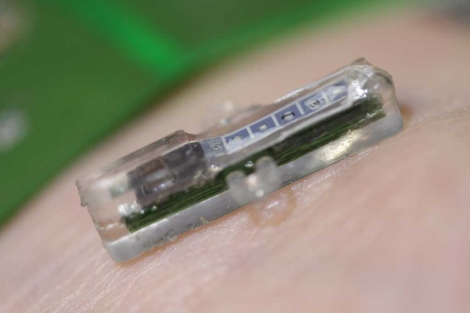Its small size (it measures 20 millimeters in length and four in height) will allow taking it in the body for long periods of time. This is the prototype of a tiny electronic implant capable of analyzing molecules in the body and send the results to a computer or any mobile device in a few minutes.
Sandro Carrara and Giovanni de Micheli, scientists from the Ecole Polytechnique Federale de Lausanne (EPFL), in Switzerland, who have developed it, show some applications of this implant. For example, the possibility to permanently track patients who are receiving chemotherapy, diabetic patients and other chronically ill so that they can reduce the frequency of traditional blood test in order to refine their doses of medication.
"The system consists of two parts. A device without battery which is placed under the skin and has a size that allows to insert it using a cannula. On the other hand, it consists of an electronic patch that is placed on the skin directly over the implant. The internal device collects information on various molecules found in the connective tissue and transmits it to the electronic patch, which in turn provides energy via electromagnetic induction. The external patch sends the information gathered by the internal implant to a smartphone or tablet via a radio transmitter. The batteries are only in the patch, so it can be replaced without removing the implant".

Carrara also says that the system is designed to be placed in the abdomen, but also can be worn on an arm or leg. According to him, the molecular analysis of connective tissue has a very high correlation with the amount of these molecules in the blood, which permits in practice to analyze the concentration of a large number of substances in our body. So far the system has been designed to detect up to five substances simultaneously. To capture each of them (glucose or lactose, for example), the five sensors are covered with an enzyme.
Scientists hope that in four years the implant can be used in hospitals and they believe it may also have a domestic use. "Potentially we can detect any substance," they say. Among them, any type of drug, but they need time to adapt the system to new applications. For its creators, this system is a step toward personalized medicine and telemedicine. In patients with chronic diseases, implants can send alerts even before symptoms appear to anticipate the need for medication. In the case of persons being subjected to a treatment, eg chemotherapy, the dose may be adjusted based on individual patient tolerance and not in the weekly analysis of blood or tables based on the age or weight.


